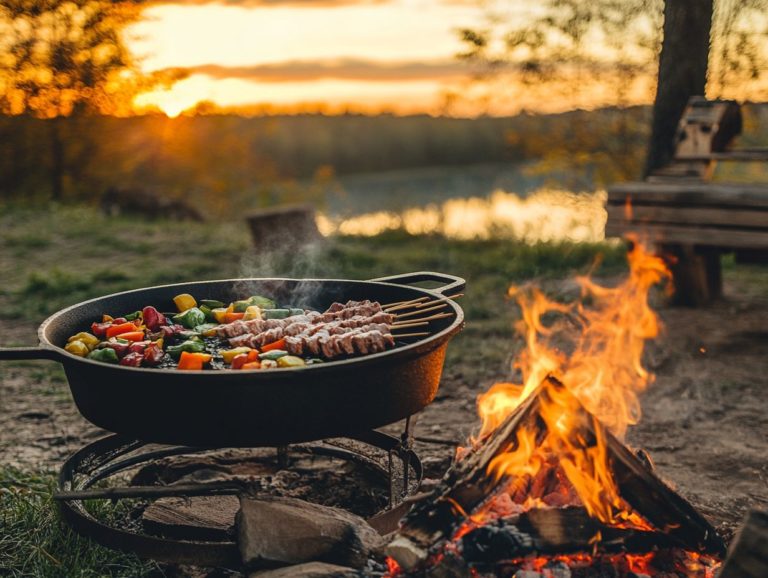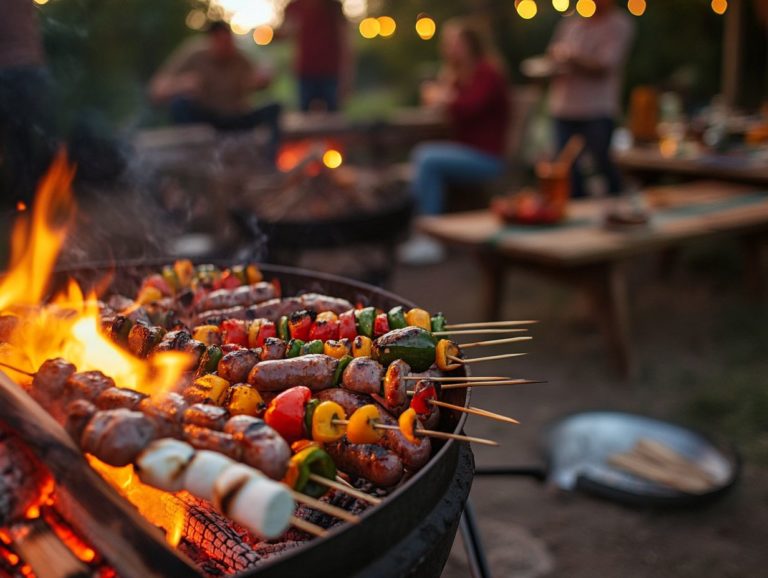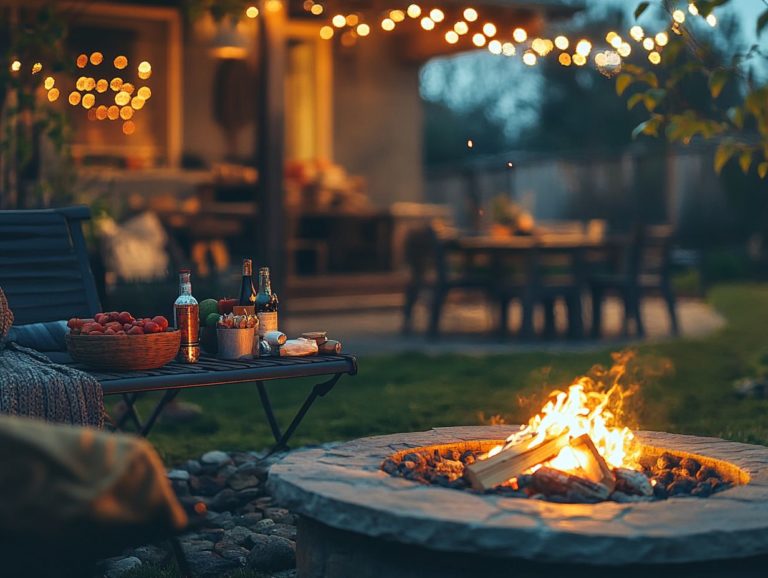Fire Pit Cooking: A Guide to Smoked Foods
Fire pit cooking transcends mere method; it embodies a rich culinary experience grounded in history and tradition.
Imagine the ancient gatherings around a crackling flame, now evolving into the modern backyard barbecues you enjoy today. Fire pits have transformed into versatile cooking tools that bring a unique flair to outdoor dining.
This guide invites you to explore various types of fire pits, essential cooking techniques, and top-notch equipment that will elevate your outdoor culinary endeavors. You ll also find delectable recipes for smoked foods and crucial safety tips to ensure your experience is both enjoyable and secure.
Get ready to ignite your creativity and savor new flavors!
Contents
- Key Takeaways:
- Types of Fire Pits
- Tools and Techniques for Fire Pit Cooking
- Preparing the Fire Pit for Cooking
- Smoked Foods to Try on the Fire Pit
- Safety Considerations for Fire Pit Cooking
- Frequently Asked Questions
- What is fire pit cooking?
- How do I set up a fire pit for cooking?
- What delicious foods can I cook on a fire pit? Discover the possibilities!
- What is the benefit of using a fire pit for cooking?
- Can I control the temperature of a fire pit for cooking?
- Are there any safety considerations for fire pit cooking?
Key Takeaways:
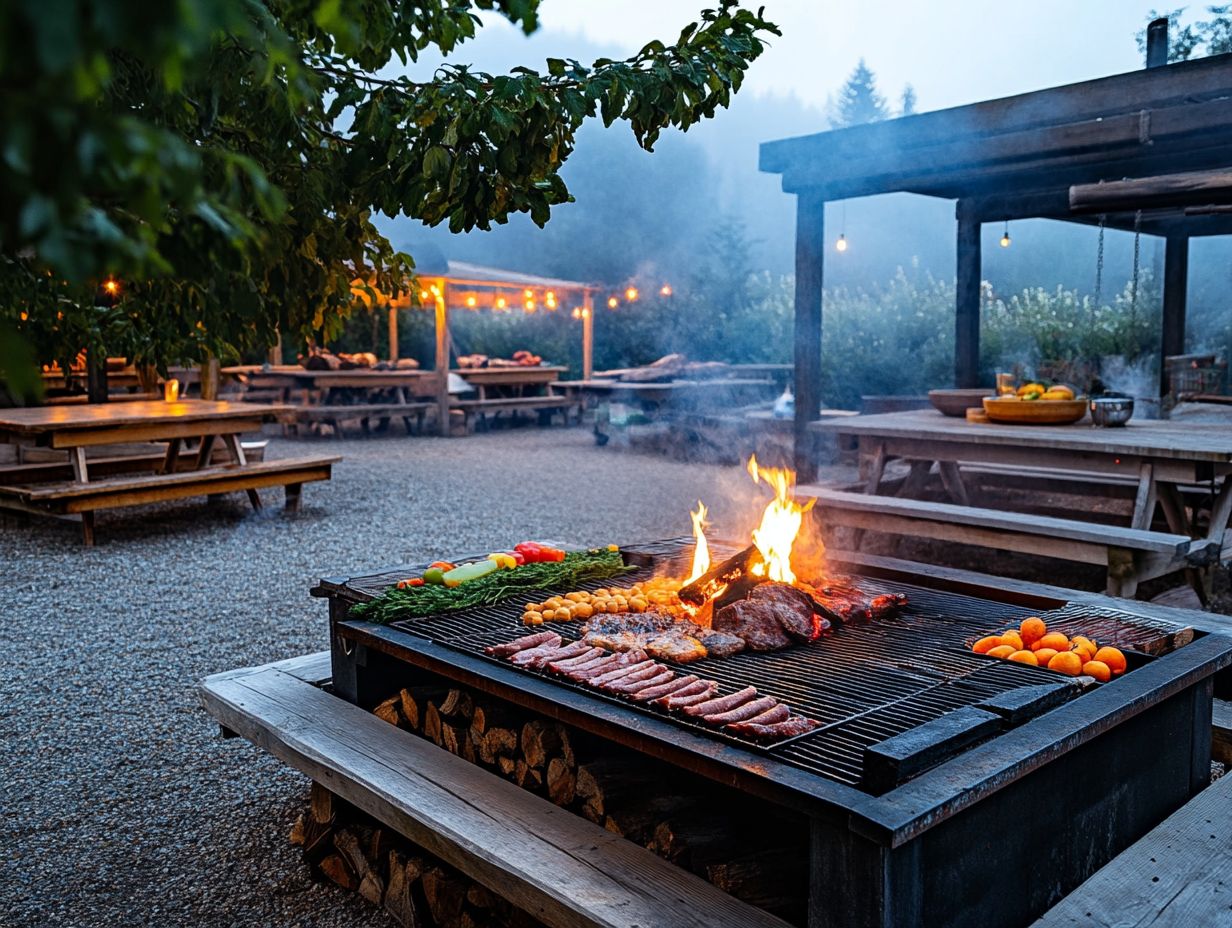
Here are some exciting insights:
- Discover the rich history and evolution of fire pit cooking and how it has become a popular method for preparing smoked foods.
- Explore the different types of fire pits and learn how to choose the right design for your cooking needs.
- Learn essential tools and techniques for successful fire pit cooking, including tips on building and maintaining the fire for optimal results.
History and Evolution of Fire Pit Cooking
The history and evolution of fire pit cooking can be traced back to ancient times when early humans harnessed fire not just for warmth but for the art of cooking. This led to the development of various outdoor cooking techniques that have transformed over centuries.
Today, you can find specialized methods like campfire cooking and low-tech approaches that highlight the importance of culinary skills and traditional flavors. Fire cooking still holds a cherished place in many cultures, reflecting a profound connection to nature and a deep appreciation for the artistry of cooking over an open flame.
In many indigenous cultures, gathering around a fire pit transcends mere dining; it becomes a communal ritual that strengthens social bonds. For example, in Native American traditions, fire pit cooking uses specific woods like hickory or mesquite, infusing dishes with distinct flavors. Mediterranean societies have embraced unique techniques, such as cooking in a tandoor a clay oven fueled by wood that imparts a smoky richness to breads and meats.
As modern outdoor cooking techniques have emerged think grilling and charcoal smokers the essence of cooking over fire remains intact. This enduring practice showcases various fuels and regional variations, from briquettes in American barbecues to the classic asado, which is a traditional South American barbecue method.
Types of Fire Pits
In the realm of outdoor cooking, understanding the nuances of different fire pit types can elevate your culinary experience to new heights. This knowledge enables you to select the method that perfectly aligns with your cooking needs and personal preferences.
Whether you choose a traditional stone setup or a sleek, modern portable grill, each fire pit offers a distinct cooking method and fuel source, infusing your dishes with unique and delightful flavors.
Comparing Different Fire Pit Designs
Comparing various fire pit designs unveils the unique functionalities and aesthetic charms of each, significantly influencing your cooking experience and results. Whether you opt for a classic wood stove that delivers efficient heat and rich flavor or a sleek, contemporary fire pit that elevates your outdoor ambiance, grasping the subtleties of fire pit cooking is crucial for your culinary triumph.
From circular stone structures to elegant metal designs, each choice offers distinct advantages. For example, a stone fire pit captivates visually while providing excellent insulation perfect for extended cooking sessions using flame-based techniques.
Conversely, a portable metal fire pit grants you the freedom to explore various cooking fuels, such as charcoal or propane. No matter the design, mastering different cooking methods from grilling skewers to utilizing cast iron pans alongside well-timed tips, can truly enhance your outdoor feasts.
The right fire pit not only enhances flavors but also crafts a warm, inviting atmosphere for gathering with friends and family.
Now that you re equipped with this knowledge, dive into these tips and start your fire pit journey today!
Tools and Techniques for Fire Pit Cooking
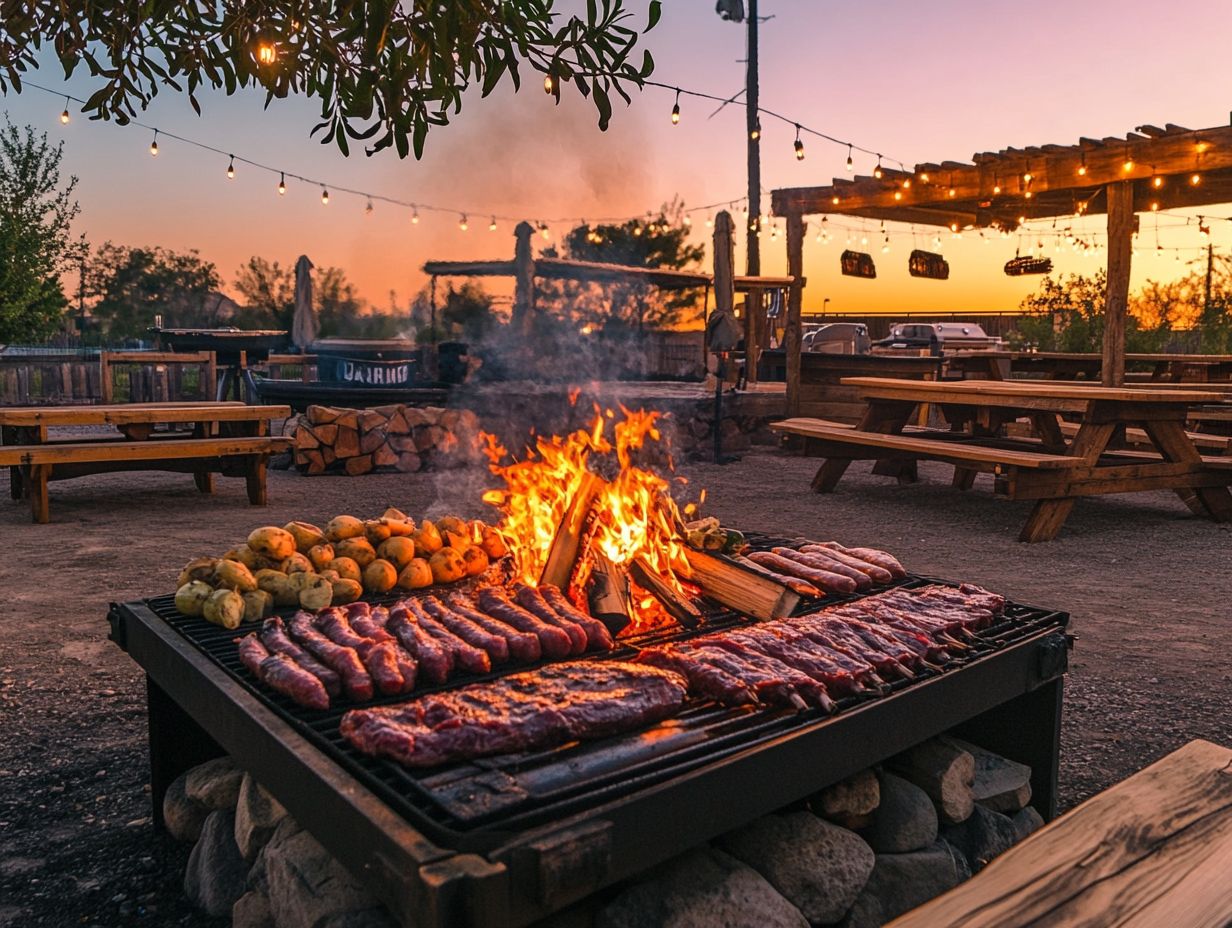
To enhance your outdoor cooking, master the tools and techniques of fire pit cooking. Using the right equipment improves your meal quality.
For instance, using cast-iron cookware ensures even heating and enhances flavor. This makes it a staple in your fire pit cooking toolkit. Coupled with effective cooking tips, you ll find your skills reaching impressive new heights.
Essential Equipment and Tips for Success
Having the right tools and mastering key cooking tips is fundamental for a successful fire pit cooking experience. This ensures that every meal is not only delicious but also safe and enjoyable.
Start with essential tools like a sturdy grate, long-handled tongs, and heat-resistant gloves. These will help you maintain control while minimizing injury risks. Incorporating cast iron cookware dramatically improves heat retention, allowing you to achieve perfectly cooked dishes.
Be sure to try out different cooking methods! From direct grilling to indirect heat for tender results, each technique brings unique flavors. Experimenting with marinades and seasonings can elevate your meals, turning simple ingredients into gourmet experiences that impress.
Preparing the Fire Pit for Cooking
Get ready! Preparing your fire pit makes all the difference. Effective fire management is the cornerstone of successful fire pit cooking.
Choose the right cooking methods now to ensure success. Create a solid base with coals and ensure your fire is primed for the culinary adventure ahead. Each element plays a vital role in enhancing flavor and ensuring safety.
Building and Maintaining the Fire
Building and maintaining the fire lays the groundwork for your culinary creations and enhances flavor development. Properly managing your fire from selecting the right cooking fuel to maintaining optimal heat levels is key to an enjoyable outdoor cooking experience.
Start by choosing the right cooking fuel. Options like seasoned hardwood, charcoal, or natural lump charcoal each bring unique flavors and heat profiles. Once the flames are dancing, arrange the wood or charcoal to encourage consistent airflow, keeping the fire strong and stable.
As you cook, regularly check the heat levels and be ready to add fuel to prevent fluctuations. Position your cooking vessels thoughtfully above the fire for even cooking while allowing smoke to escape, enhancing the overall flavor of your dishes.
Smoked Foods to Try on the Fire Pit
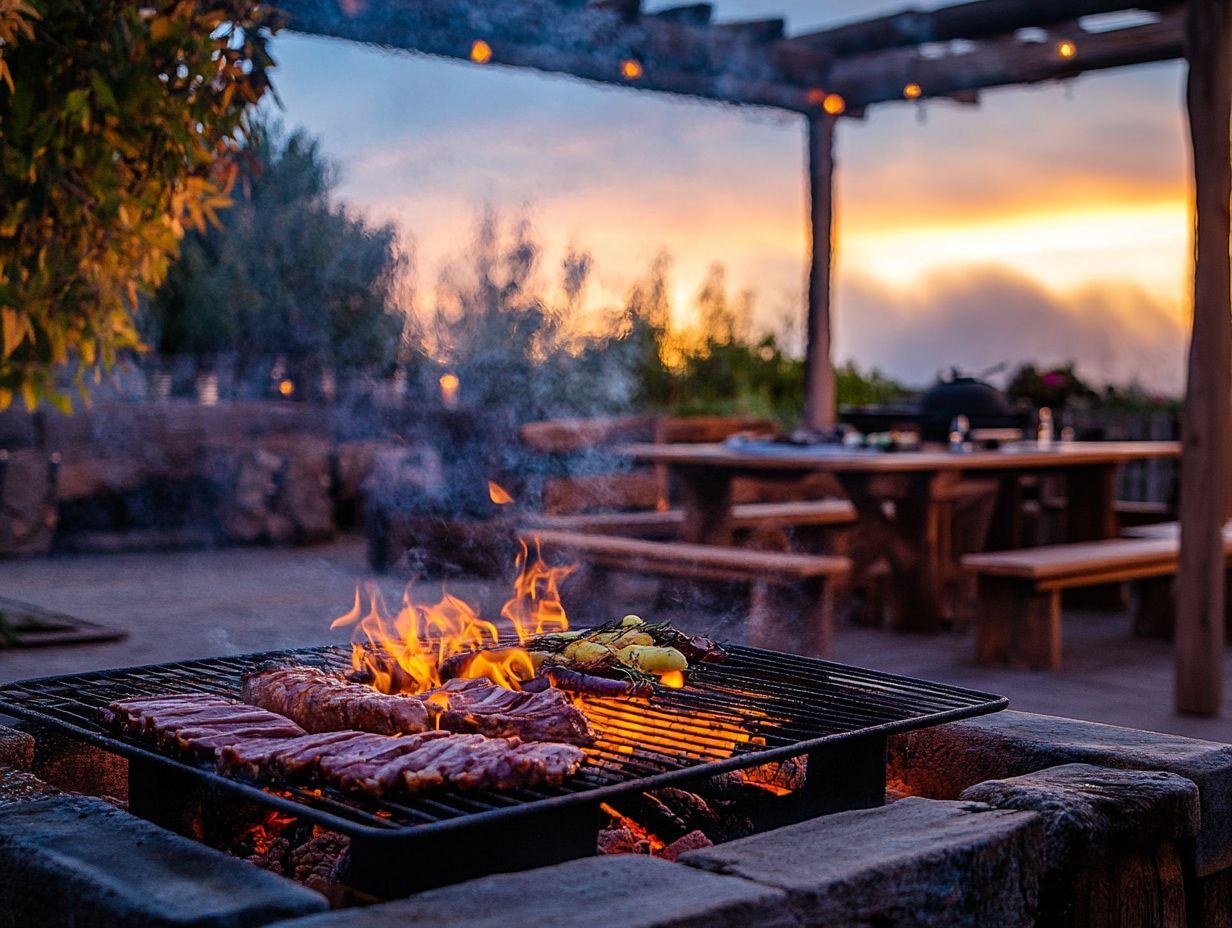
Exploring the array of smoked foods you can create on your fire pit opens up a world of culinary possibilities. Picture yourself mastering classic smoked meats like brisket and ribs, while also venturing into adventurous choices like lamb or goat. For even more inspiration, check out fire pit cooking recipes from around the globe.
Cooking outdoors on a fire pit offers a unique depth of flavor that can transform any dish into an extraordinary experience, especially when you explore fire pit cooking: the best types of meat.
Recipes and Tips for Delicious Smoked Meals
Creating delicious smoked meals requires a blend of well-researched recipes and cooking tips for fire pit cooking tailored specifically for methods over a fire pit. This ensures flavors harmonize beautifully in every bite.
Whether you’re preparing smoked chicken, brisket, or ribs, following specific guidelines can significantly enhance both the flavor and tenderness of your smoked meat.
To embark on this mouthwatering journey, selecting the right type of wood chips is crucial. Each variety imparts its own unique aromas and nuances to your dish. For example, hickory delivers a robust and hearty flavor, while applewood offers a sweeter, milder smokiness that pairs wonderfully with poultry and fish.
Marinating your proteins is a game-changer! It boosts flavor and tenderness like nothing else, allowing spices and seasonings to penetrate evenly.
Keep an eye on the cooking temperature. Maintaining a steady, low heat is key to achieving that perfect tenderness while creating a deliciously smoky crust on the outside.
Safety Considerations for Fire Pit Cooking
Safety considerations for fire pit cooking are essential. They ensure a secure and enjoyable experience while minimizing the risks tied to fire and food preparation.
Understand best practices such as maintaining a safe distance and employing appropriate cooking techniques. By adhering to safety guidelines, you can fully enjoy the art of fire cooking without sacrificing safety.
Precautions and Best Practices
Implementing precautions and best practices for fire pit cooking is essential. This ensures your outdoor culinary adventures are both enjoyable and safe.
Be aware of potential hazards and adhere to established guidelines to significantly reduce risks associated with fire and equipment.
Choose a stable and suitable location for your fire pit, far from flammable materials and structures. Keep your cooking tools, like long-handled utensils and heat-resistant gloves, within easy reach to prevent burns and accidents.
Maintain a manageable fire size to help control heat and minimize the risk of flare-ups. Always use separate utensils for raw and cooked items to avoid cross-contamination (the transfer of harmful bacteria between raw and cooked foods), keeping everyone safe from foodborne illnesses.
Being mindful of the smoke and embers will also contribute to a safer cooking environment. This allows you to focus on what truly matters: savoring your delicious creations.
Frequently Asked Questions
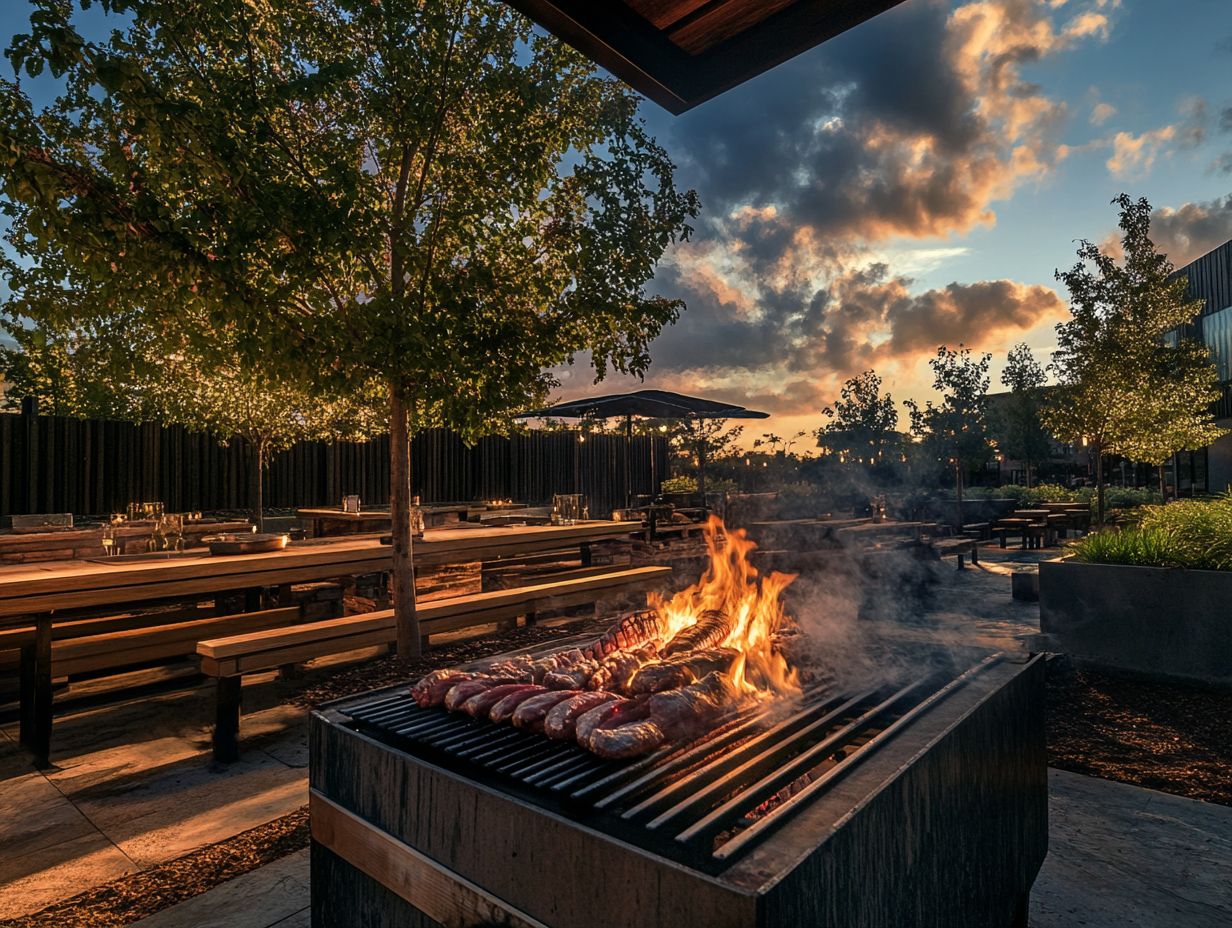
What is fire pit cooking?
Fire pit cooking is the process of preparing food using a fire pit as the main source of heat. This ancient method provides a unique, smoky flavor to foods, and you can explore unique fire pit cooking techniques to try.
How do I set up a fire pit for cooking?
To set up a fire pit for cooking, start by selecting a level, non-flammable location. You can dig a hole in the ground or use a metal fire pit ring. Add firewood to the pit and light it, allowing the flames to die down and the wood to turn to hot coals before cooking.
What delicious foods can I cook on a fire pit? Discover the possibilities!
Fire pit cooking can be used for a variety of foods, including meats, vegetables, and even desserts. For those looking to enhance their techniques, exploring the art of fire pit cooking offers tips from chefs on popular options like smoked meats, grilled vegetables, and campfire classics like s’mores.
What is the benefit of using a fire pit for cooking?
Using a fire pit for cooking provides a unique, smoky flavor to foods that cannot be replicated with other cooking methods. For the best results, consider choosing the right ingredients, and it also allows for outdoor cooking without the need for a traditional grill or stove.
Can I control the temperature of a fire pit for cooking?
Yes! You can control the temperature by adjusting the amount of firewood used and the placement of the food. For lower temperatures, use fewer coals or move the food to the edges of the pit. For higher temperatures, add more coals or place the food directly over the hot coals.
Are there any safety considerations for fire pit cooking?
Absolutely! Always use caution when working with fire. Keep a fire extinguisher nearby. Make sure to properly extinguish the fire when finished cooking and never leave a fire unattended.
Ready to experience the joy of fire pit cooking? Gather your friends, choose a recipe, and ignite your culinary adventure!

